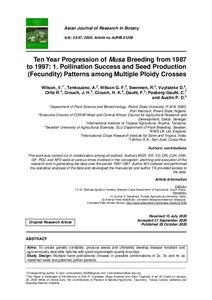| dc.contributor.author | Wilson, V. |
| dc.contributor.author | Tenkouano, A. |
| dc.contributor.author | Wilson, G.F. |
| dc.contributor.author | Swennen, R. |
| dc.contributor.author | Vuylsteke, D. |
| dc.contributor.author | Ortiz, R. |
| dc.contributor.author | Crouch, J.H. |
| dc.contributor.author | Crouch, H.K. |
| dc.contributor.author | Gauhl, F. |
| dc.contributor.author | Pasberg-Gauhl, C. |
| dc.contributor.author | Austin, P.D. |
| dc.date.accessioned | 2021-02-15T10:34:47Z |
| dc.date.available | 2021-02-15T10:34:47Z |
| dc.date.issued | 2020 |
| dc.identifier.citation | Wilson, V., Tenkouano, A., Wilson, G.F., Swennen, R., Vuylsteke, D., Ortiz, R., ... & Austin, P.D. (2020). Ten Year Progression of Musa Breeding from 1987 to 1997: 1. Pollination Success and Seed Production (Fecundity) Patterns among Multiple Ploidy Crosses. Asian Journal of Research in Botany, 4(4), 53-67. |
| dc.identifier.uri | https://hdl.handle.net/20.500.12478/7037 |
| dc.description.abstract | Aims: To create genetic variability, produce seeds and ultimately develop disease resistant and agronomically desirable hybrids with good organoleptic quality bunches. Study Design: Multiple hand pollinations/ crosses in possible combinations of 2x, 3x and 4x as maternal/ seed and paternal/ pollen parents. Place and Duration of Study: International Institute of Tropical Agriculture High Rainfall Station (IITA), Onne, Rivers State, Nigeria. 1987 to 1997. Methodology: Utilizing over 320 landraces, varieties, cultivars, clones/ genotypes and IITA accessions obtained from plantain and banana growing regions worldwide, scientists performed numerous hand pollinations/ crosses in possible combinations of 2x, 3x and 4x as maternal/ seed and paternal/ pollen parents every day. Results: There were significant differences (P=.05) in number of seeds produced when diploids were used as maternal parents. Overall, 2x-2x produced 11times more seeds than the 2x-3x, and 54times more seeds than the 2x-4x. The 2x-2x crosses had double seed production maxima when crosses took place in June and July (8,300 seeds) and August and November (6,200 seeds) indicating a high level of fecundity. Only 2x-2x showed significantly positive correlation between seed production and pollination success (r = 0.617*). When triploids were maternal parents, there were significant differences (P=.05) in number of seeds produced. On average, 3x-2x produced 4times the number of seeds obtained from 3x-3x and 27times more than 3x-4x crosses. Seed production from triploids was 32times less than from diploids. The 3x-3x exhibited positively significant correlation between seed production and pollination success (r = 0.595*). With tetraploid maternal parents, there was significant difference (P=.05) in seed production when the male parent was diploid. High seed production (3,000-4,000) was achieved when pollination took place from June to October in the 4x-2x crosses. Seed production and pollination success in the 4x-2x were positively and highly significantly correlated (r = 0.865**). Conclusion: In all crosses, diploid males produced the most seeds and pollination success increased as ploidy of maternal parent increased from diploid to tetraploid especially with diploid males. |
| dc.description.sponsorship | International Institute of Tropical Agriculture |
| dc.format.extent | 53-67 |
| dc.language.iso | en |
| dc.subject | Genetic Improvement |
| dc.subject | Genomes |
| dc.subject | Ploidy |
| dc.subject | Musa |
| dc.subject | Plant Breeding |
| dc.subject | Plant Production |
| dc.subject | Pollination |
| dc.title | Ten year progression of Musa breeding from 1987 to 1997: 1. Pollination success and seed production (Fecundity) patterns among multiple ploidy crosses |
| dc.type | Journal Article |
| cg.contributor.crp | Roots, Tubers and Bananas |
| cg.contributor.affiliation | Rivers State University |
| cg.contributor.affiliation | West and Central African Council for Agricultural Research and Development |
| cg.contributor.affiliation | International Institute of Tropical Agriculture |
| cg.contributor.affiliation | Swedish University of Agricultural Sciences |
| cg.contributor.affiliation | KWS UK Ltd, England |
| cg.contributor.affiliation | International Crop Research Institute for the Semi-Arid Tropics |
| cg.contributor.affiliation | Tafrilico S.A., San José, Costa Rica |
| cg.coverage.region | Africa |
| cg.coverage.region | West Africa |
| cg.coverage.country | Nigeria |
| cg.coverage.hub | Eastern Africa Hub |
| cg.researchtheme | Biotech and Plant Breeding |
| cg.identifier.bibtexciteid | WILSON:2020 |
| cg.authorship.types | CGIAR and developing country institute |
| cg.iitasubject | Agronomy |
| cg.iitasubject | Cassava |
| cg.iitasubject | Genetic Improvement |
| cg.iitasubject | Plant Breeding |
| cg.iitasubject | Plant Production |
| cg.iitasubject | Plantain |
| cg.journal | Asian Journal of Research in Botany |
| cg.notes | Open Access Article; Published online: 05 Oct 2020 |
| cg.accessibilitystatus | Open Access |
| cg.reviewstatus | Peer Review |
| cg.usagerightslicense | Creative Commons Attribution 4.0 (CC BY 0.0) |
| cg.targetaudience | Scientists |
| cg.iitaauthor.identifier | Rony Swennen: 0000-0002-5258-9043 |
| cg.futureupdate.required | No |

